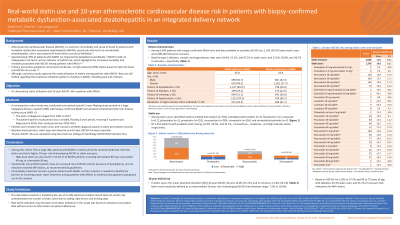Monday Poster Session
Category: Liver
P2875 - Real-World Statin Use and 10-Year Atherosclerotic Cardiovascular Disease Risk in Patients With Biopsy-Confirmed Metabolic Dysfunction Associated Steatohepatitis in an Integrated Delivery Network
Monday, October 28, 2024
10:30 AM - 4:00 PM ET
Location: Exhibit Hall E

Has Audio
- YK
Yestle Kim, PharmD, MS
Madrigal Pharmaceuticals
Conshohocken, PA
Presenting Author(s)
Yestle Kim, PharmD, MS1, Pete Vu, PharmD1, Lars Hegstrom, MD2
1Madrigal Pharmaceuticals, Conshohocken, PA; 2nference, Cambridge, MA
Introduction: ASCVD is a common comorbidity and cause of death in patients with MASH, previously referred to as nonalcoholic steatohepatitis, and is associated with heart failure and atrial fibrillation. Patients with MASH are likely to have or develop dyslipidemia. Primary prevention guidelines recommend moderate-to-high intensity (MHI) statins based on lipid risk levels and ASCVD risk scores. Our objective was to characterize statin utilization and 10-year ASCVD risk in patients with MASH.
Methods: A retrospective cohort study was conducted over 5 years of patients in a large IDN with biopsy-confirmed MASH and elevated NAS >3. Patients were divided into statin users and nonusers. 10-year ASCVD risk was calculated using the American College of Cardiology ASCVD Risk Estimator Plus.
Results: 3,442 MASH patients had data available to calculate ASCVD risk – 1,359 (39.5%) statin users and 2,083 (60.5%) nonusers. Baseline type 2 diabetes, smoker, and hypertension rates were 29.4%, 51.1%, and 97.2% in statin users and 22.6%, 30.8%, and 36.7% in nonusers. Identified statins included atorvastatin (n=756), amlodipine/atorvastatin (n=3), fluvastatin (n=1), lovastatin (n=12), pitavastatin (n=1), pravastatin (n=152), rosuvastatin (n=290), simvastatin (n=136), and simvastatin/ezetimibe (n=2). Of 1,352 patients with available statin dosing, 33.1%, 56.5%, and 10.4% received high, moderate, and low-intensity doses, respectively. In statin users, the mean (standard deviation [SD]) 10-year ASCVD risk was 16.0% (15.1%) and in nonusers, 11.6% (13.1%). Both results would be defined as an intermediate 10-year risk of developing ASCVD (intermediate range: 7.5% to 19.9%). 45.3% and 31.1% of statin users and nonusers had indications for MHI statins based on ASCVD risk ≥15% or ≥7.5% aged 40-75 with diabetes.
Discussion: Among this cohort from a large IDN, MASH patients on statins primarily received moderate-intensity statins and had a higher 10-year risk of developing ASCVD versus statin nonusers. 33.1% of all MASH patients received common high-dose statins, including atorvastatin 80 mg, rosuvastatin 40mg, or simvastatin 80mg. Importantly, many MASH patients have an increased risk of ASCVD and the presence of dyslipidemia, yet not everyone received MHI statins, as recommended by guidelines. This descriptive research is limited by the use of an IDN electronic medical record data set, which may underestimate statin users, and incomplete dosing information.
Note: The table for this abstract can be viewed in the ePoster Gallery section of the ACG 2024 ePoster Site or in The American Journal of Gastroenterology's abstract supplement issue, both of which will be available starting October 27, 2024.
Disclosures:
Yestle Kim, PharmD, MS1, Pete Vu, PharmD1, Lars Hegstrom, MD2. P2875 - Real-World Statin Use and 10-Year Atherosclerotic Cardiovascular Disease Risk in Patients With Biopsy-Confirmed Metabolic Dysfunction Associated Steatohepatitis in an Integrated Delivery Network, ACG 2024 Annual Scientific Meeting Abstracts. Philadelphia, PA: American College of Gastroenterology.
1Madrigal Pharmaceuticals, Conshohocken, PA; 2nference, Cambridge, MA
Introduction: ASCVD is a common comorbidity and cause of death in patients with MASH, previously referred to as nonalcoholic steatohepatitis, and is associated with heart failure and atrial fibrillation. Patients with MASH are likely to have or develop dyslipidemia. Primary prevention guidelines recommend moderate-to-high intensity (MHI) statins based on lipid risk levels and ASCVD risk scores. Our objective was to characterize statin utilization and 10-year ASCVD risk in patients with MASH.
Methods: A retrospective cohort study was conducted over 5 years of patients in a large IDN with biopsy-confirmed MASH and elevated NAS >3. Patients were divided into statin users and nonusers. 10-year ASCVD risk was calculated using the American College of Cardiology ASCVD Risk Estimator Plus.
Results: 3,442 MASH patients had data available to calculate ASCVD risk – 1,359 (39.5%) statin users and 2,083 (60.5%) nonusers. Baseline type 2 diabetes, smoker, and hypertension rates were 29.4%, 51.1%, and 97.2% in statin users and 22.6%, 30.8%, and 36.7% in nonusers. Identified statins included atorvastatin (n=756), amlodipine/atorvastatin (n=3), fluvastatin (n=1), lovastatin (n=12), pitavastatin (n=1), pravastatin (n=152), rosuvastatin (n=290), simvastatin (n=136), and simvastatin/ezetimibe (n=2). Of 1,352 patients with available statin dosing, 33.1%, 56.5%, and 10.4% received high, moderate, and low-intensity doses, respectively. In statin users, the mean (standard deviation [SD]) 10-year ASCVD risk was 16.0% (15.1%) and in nonusers, 11.6% (13.1%). Both results would be defined as an intermediate 10-year risk of developing ASCVD (intermediate range: 7.5% to 19.9%). 45.3% and 31.1% of statin users and nonusers had indications for MHI statins based on ASCVD risk ≥15% or ≥7.5% aged 40-75 with diabetes.
Discussion: Among this cohort from a large IDN, MASH patients on statins primarily received moderate-intensity statins and had a higher 10-year risk of developing ASCVD versus statin nonusers. 33.1% of all MASH patients received common high-dose statins, including atorvastatin 80 mg, rosuvastatin 40mg, or simvastatin 80mg. Importantly, many MASH patients have an increased risk of ASCVD and the presence of dyslipidemia, yet not everyone received MHI statins, as recommended by guidelines. This descriptive research is limited by the use of an IDN electronic medical record data set, which may underestimate statin users, and incomplete dosing information.
Note: The table for this abstract can be viewed in the ePoster Gallery section of the ACG 2024 ePoster Site or in The American Journal of Gastroenterology's abstract supplement issue, both of which will be available starting October 27, 2024.
Disclosures:
Yestle Kim: Madrigal – Employee.
Pete Vu: Madrigal – Employee.
Lars Hegstrom: nference – Employee, Stock-privately held company.
Yestle Kim, PharmD, MS1, Pete Vu, PharmD1, Lars Hegstrom, MD2. P2875 - Real-World Statin Use and 10-Year Atherosclerotic Cardiovascular Disease Risk in Patients With Biopsy-Confirmed Metabolic Dysfunction Associated Steatohepatitis in an Integrated Delivery Network, ACG 2024 Annual Scientific Meeting Abstracts. Philadelphia, PA: American College of Gastroenterology.
